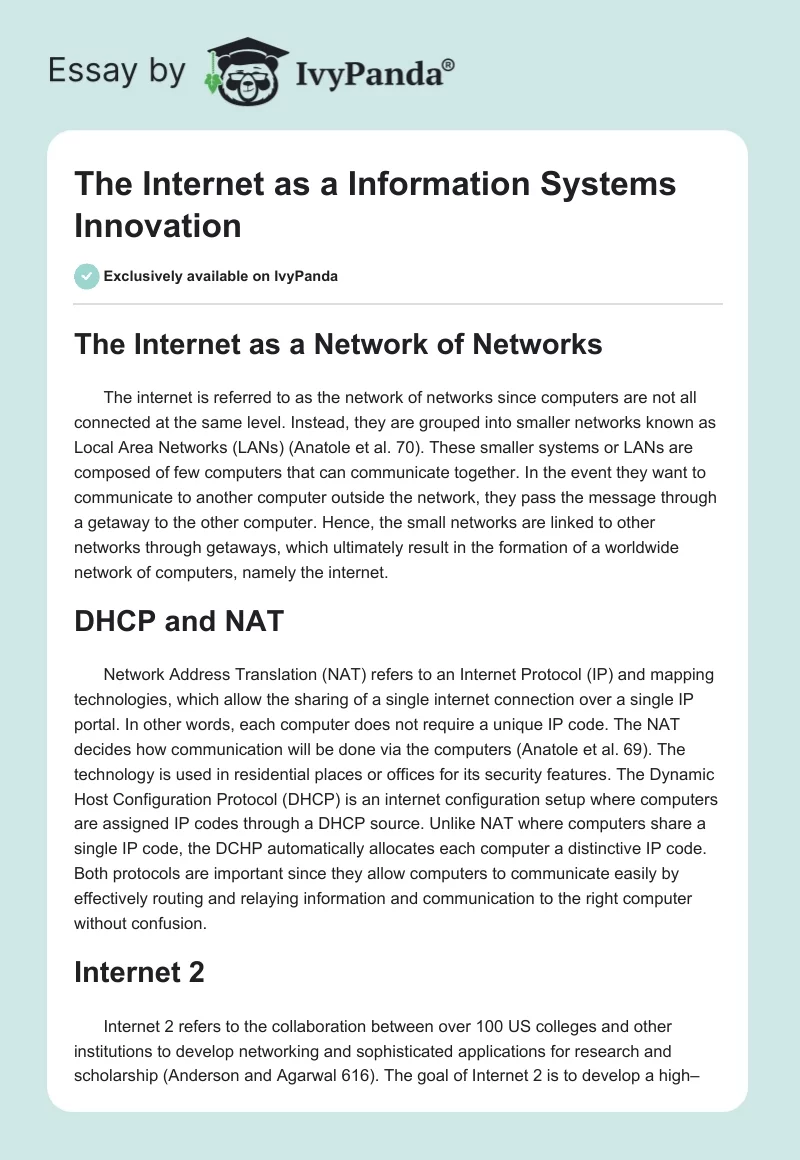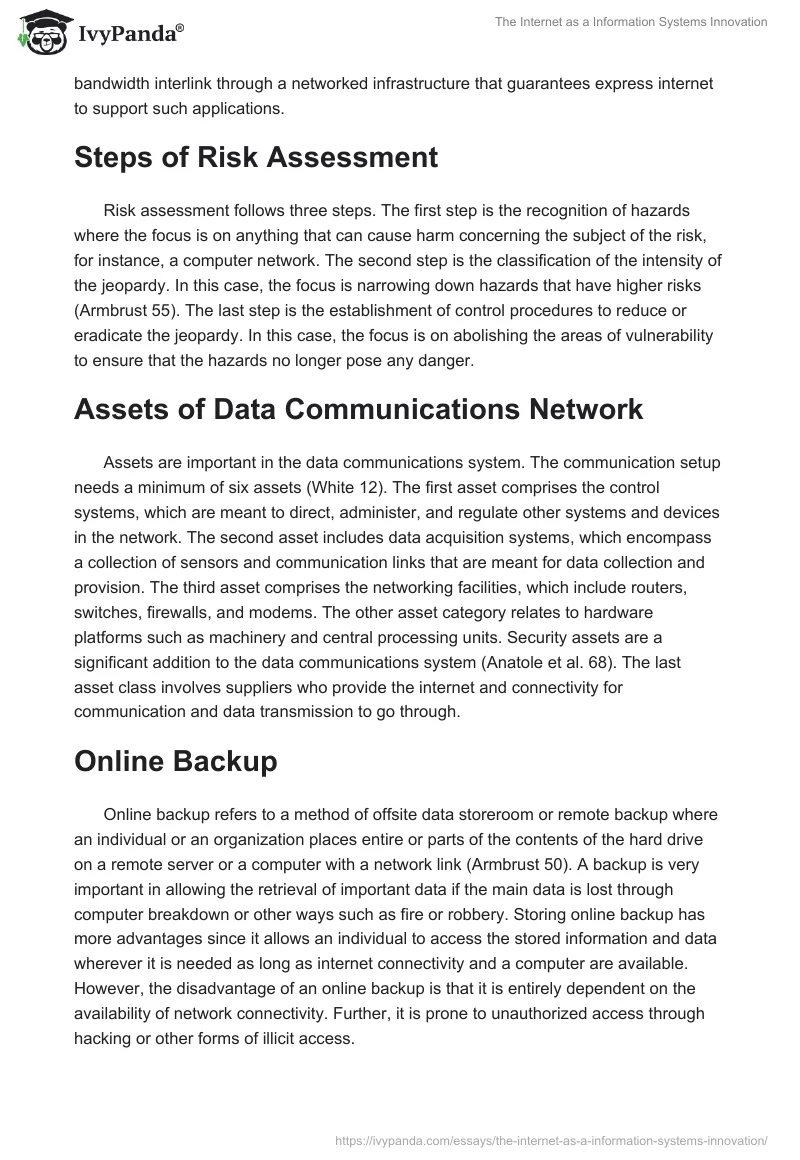The Internet as a Network of Networks
The internet is referred to as the network of networks since computers are not all connected at the same level. Instead, they are grouped into smaller networks known as Local Area Networks (LANs) (Anatole et al. 70). These smaller systems or LANs are composed of few computers that can communicate together. In the event they want to communicate to another computer outside the network, they pass the message through a getaway to the other computer. Hence, the small networks are linked to other networks through getaways, which ultimately result in the formation of a worldwide network of computers, namely the internet.
DHCP and NAT
Network Address Translation (NAT) refers to an Internet Protocol (IP) and mapping technologies, which allow the sharing of a single internet connection over a single IP portal. In other words, each computer does not require a unique IP code. The NAT decides how communication will be done via the computers (Anatole et al. 69). The technology is used in residential places or offices for its security features. The Dynamic Host Configuration Protocol (DHCP) is an internet configuration setup where computers are assigned IP codes through a DHCP source. Unlike NAT where computers share a single IP code, the DCHP automatically allocates each computer a distinctive IP code. Both protocols are important since they allow computers to communicate easily by effectively routing and relaying information and communication to the right computer without confusion.
Internet 2
Internet 2 refers to the collaboration between over 100 US colleges and other institutions to develop networking and sophisticated applications for research and scholarship (Anderson and Agarwal 616). The goal of Internet 2 is to develop a high–bandwidth interlink through a networked infrastructure that guarantees express internet to support such applications.
Steps of Risk Assessment
Risk assessment follows three steps. The first step is the recognition of hazards where the focus is on anything that can cause harm concerning the subject of the risk, for instance, a computer network. The second step is the classification of the intensity of the jeopardy. In this case, the focus is narrowing down hazards that have higher risks (Armbrust 55). The last step is the establishment of control procedures to reduce or eradicate the jeopardy. In this case, the focus is on abolishing the areas of vulnerability to ensure that the hazards no longer pose any danger.
Assets of Data Communications Network
Assets are important in the data communications system. The communication setup needs a minimum of six assets (White 12). The first asset comprises the control systems, which are meant to direct, administer, and regulate other systems and devices in the network. The second asset includes data acquisition systems, which encompass a collection of sensors and communication links that are meant for data collection and provision. The third asset comprises the networking facilities, which include routers, switches, firewalls, and modems. The other asset category relates to hardware platforms such as machinery and central processing units. Security assets are a significant addition to the data communications system (Anatole et al. 68). The last asset class involves suppliers who provide the internet and connectivity for communication and data transmission to go through.
Online Backup
Online backup refers to a method of offsite data storeroom or remote backup where an individual or an organization places entire or parts of the contents of the hard drive on a remote server or a computer with a network link (Armbrust 50). A backup is very important in allowing the retrieval of important data if the main data is lost through computer breakdown or other ways such as fire or robbery. Storing online backup has more advantages since it allows an individual to access the stored information and data wherever it is needed as long as internet connectivity and a computer are available. However, the disadvantage of an online backup is that it is entirely dependent on the availability of network connectivity. Further, it is prone to unauthorized access through hacking or other forms of illicit access.
Components in Typical Policy
A security policy has several components. Among these components, three typical components seem outstanding. The first component is the rationale (Hutchins, Cloppert, and Amin 80). The rationale indicates the main objectives that the security feature is meant to address such as reducing the cost of data loss and improvement of recovery times. The second constituent of a security policy is scope or span. The span relates to the guidance of what and whom the security policy covers. The span may indicate the departments, organizations, processes, and lines of business among other areas of coverage as defined by the security policy. The third important element is the responsibilities. This constituent defines who handles the functionality of the security policy. The identified party oversees its successful implementation.
Physical Security
Physical security refers to the measures that an entity undertakes to protect property, paraphernalia, software, and information from physical actions that can cause severe damage or loss of such resources or an organization. Physical security is very important since it allows organizations or individuals to protect their property from events such as fire, flooding, and burglary among other substantial occurrences that can cause grave harm to possessions, which are vital for the functionality of an organization. Some of the examples of physical security measures include anti-burglary doors, fireproof cabinets and rooms, and firefighting equipment.
Symmetric and Asymmetric Encryption
Symmetric encryption refers to an encoding technique, which uses surreptitious words, a numeral, or a string of haphazard letters to change the content of the message in a particular manner, which can only be decoded by parties that have the concealed marks, numerals, or the string of scripts (Anderson and Agarwal 615). As long as the correspondent and the beneficiary have the undisclosed key, they can encrypt and decode the messages by entering the key.
Asymmetrical encryption overcomes the shortcoming of surreptitious keys by applying two related keys (Anderson and Agarwal 615). In the symmetrical encoding, whoever has the underground key can encrypt and decode the message. In the asymmetrical encryption, this shortcoming is overcome by the use of a second tool, namely the duo key. In this case, the first key is made public, meaning that anyone can send a message to another individual. However, the message can only be decrypted using the second key, which is kept private.
Biometric System
Biometric security systems are used for the identification and authentication of people via their fingerprints or voices among other features (Nagar, Nandakumar, and Jain 52). Biometric systems can improve security by ensuring an elaborate database of people who access a given location. An organization can track the movement of people in and outside a location, hence allowing easy tracking of security breaches.
Computer Forensics
Computer forensics relates to the application of investigative and diagnostic techniques of gathering and storing evidence. Such substantiation may be availed in a court of law.
Green IT
Green IT is a concept that relates to the efforts that are dedicated to the sustainable use of Information Technology and related resources (Melville 4). Green IT is important since it finds applications virtually in all fields of business. IT-related emissions can have negative impacts on the environment and hence the need to control such effects.
Works Cited
Anatole, Lécuyer, Fabien Lotte, Richard Reilly, Robert Leeb, Michitaka Hirose, and Mel Slater. “Brain-computer interfaces, virtual reality, and video games.”Computer 10.1(2008): 66-72. Print.
Anderson, Catherine, and Ritu Agarwal. “Practicing safe computing: a multimedia empirical examination of home computer user security behavioral intentions.” MIS Quarterly 34.3 (2010): 613-643. Print.
Armbrust, Michael. “A view of cloud computing.” Communications of the ACM 53.4 (2010): 50-58. Print.
Hutchins, Eric, Michael Cloppert, and Rohan Amin. “Intelligence-driven computer network defense informed by analysis of adversary campaigns and intrusion kill chains.” Leading Issues in Information Warfare & Security Research 1.1 (2011): 80-84. Print.
Melville, Nigel. “Information systems innovation for environmental sustainability.” MIS Quarterly 34.1(2010): 1-21. Print.
Nagar, Abhishek, Karthik Nandakumar, and Anil Jain. Biometric template transformation: a security analysis. Michigan, MI: Michigan State University, 2010. Print.
White, Curt. Data Communications and Computer Networks. Boston, MA: Cengage Learning, 2012. Print.


